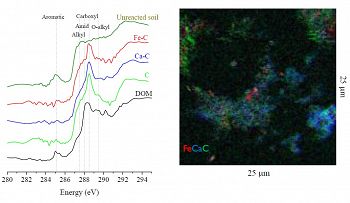Olshansky et al., 2018
Wet–dry cycles impact DOM retention in subsurface soils
Olshansky Y., Root R.A., and Chorover J. (2018)
Biogeosciences 15: 821-832
-
Catalina-Jemez, INVESTIGATOR
Abstract
JRB soil reacted with DOM under wet-dry cycling. Left, C NEXAFS spectra extracted from C, Ca, and Fe regions of STXM map. Spectra of unreacted soil (top) and DOM solution (bottom) are presented. Dashed vertical lines point out C species. Right, tri-colored STXM map of fine fraction from JRB soil reacted four times with DOM under wet-dry cycling; Fe (red), Ca (blue) and C (green). Image size 25 x 25 um. For color rendering of this image please refer to the online version.
Transport and reactivity of carbon in the critical zone are highly controlled by reactions of dissolved organic matter (DOM) with subsurface soils, including adsorption, transformation and exchange. These reactions are dependent on frequent wet-dry cycles common to the unsaturated zone, particularly in semi-arid regions. To test for an effect of wet-dry cycles on DOM interaction and stabilization in subsoils, samples were collected from subsurface (Bw) horizons of an Entisol and an Alfisol from the Catalina-Jemez Critical Zone Observatory and sequentially reacted (four batch steps) with DOM extracted from the corresponding soil litter layers. Between each reaction step, soils either were allowed to air dry (wet-dry treatment) before introduction of the following DOM solution or were maintained under constant wetness (continually-wet treatment). Microbial degradation was the dominant mechanism of DOM loss from solution for the Entisol subsoil, which had higher initial organic C content, whereas sorptive retention predominated in the lower C Alfisol subsoil. For a given soil, bulk dissolved organic C losses from solution were similar across treatments. However, a combination of Fourier transform infrared (FTIR) and near edge X-ray absorption fine structure (NEXAFS) spectroscopic analyses revealed that wet-dry treatments enhanced the interactions between carboxyl functional groups and soil particle surfaces and scanning transmission X-ray microscopy (STXM) data suggested that cation bridging by Ca2+ was the primary mechanism for carboxyl association with soil surfaces. STXM data also showed that spatial fractionation of adsorbed OM on soil organo-mineral surfaces was diminished relative to what might be inferred from previously published observations pertaining to DOM fractionation on reaction with specimen mineral phases. This study provides direct evidence of the role of wet-dry cycles in affecting sorption reactions of DOM to a complex soil matrix. In the soil environment, where wet-dry cycles occur at different frequencies from site to site and along the soil profile, different interactions between DOM and soil surfaces are expected and needs to be consider for the overall assessment of carbon dynamics.
Citation
Olshansky Y., Root R.A., and Chorover J. (2018): Wet–dry cycles impact DOM retention in subsurface soils. Biogeosciences 15: 821-832. DOI: 10.5194/bg-15-821-2018
 This Paper/Book acknowledges NSF CZO grant support.
This Paper/Book acknowledges NSF CZO grant support.
Explore Further


